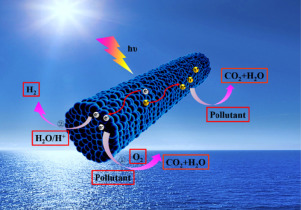当前位置:
X-MOL 学术
›
Chin. J. Catal.
›
论文详情
Our official English website, www.x-mol.net, welcomes your
feedback! (Note: you will need to create a separate account there.)
Hydrogen producing water treatment through mesoporous TiO2 nanofibers with oriented nanocrystals
Chinese Journal of Catalysis ( IF 15.7 ) Pub Date : 2020-01-01 , DOI: 10.1016/s1872-2067(19)63424-8 Guocheng Huang , Xueyan Liu , Shuangru Shi , Sitan Li , Zhengtao Xiao , Weiqian Zhen , Shengwei Liu , Po Keung Wong
Chinese Journal of Catalysis ( IF 15.7 ) Pub Date : 2020-01-01 , DOI: 10.1016/s1872-2067(19)63424-8 Guocheng Huang , Xueyan Liu , Shuangru Shi , Sitan Li , Zhengtao Xiao , Weiqian Zhen , Shengwei Liu , Po Keung Wong

|
Abstract The development of well-defined TiO2 nanoarchitectures is a versatile strategy to achieve high-efficiency photocatalytic performance. In this study, mesoporous TiO2 nanofibers consisting of oriented nanocrystals were fabricated by a facile vapothermal-assisted topochemical transformation of preformed H-titanate nanobelts. The vapothermal temperature is crucial in tuning the microstructures and photocatalytic redox properties of the resulting mesoporous TiO2 nanofibers. The microstructures were characterized with XRD, TEM, XPS and nitrogen adsorption-desorption isotherms, etc. The photocatalytic activities were evaluated by photocatalytic oxidation of organic pollutant (Rhodamine B as an example) as well as photocatalytic reduction of water to generate hydrogen (H2). The nanofibers vapothermally treated at 150°C showed the highest photocatalytic activity in both oxidation and reduction reactions, 2 times higher than that of P25. The oriented alignment and suitable mesoporosity in the resulting nanofiber architecture were crucial for enhancing photocatalytic performances. The oriented alignment of anisotropic anatase nanocrystals shall facilitate faster vectorial charge transportation along the nanofibers architecture. And, the suitable mesoporosity and high surface area would also effectively enhance the mass exchange during photocatalytic reactions. We also demonstrate that efficient energy-recovering photocatalytic water treatments could be accomplished by a cascading oxic-anoxic process where the dye is degraded in the oxic phase and hydrogen is generated in the successive anoxic phase. This study showcases a novel and facile method to fabricate mesoporous TiO2 nanofibers with high photocatalytic activity for both clean energy production and environmental purification.
中文翻译:

通过具有取向纳米晶体的介孔 TiO2 纳米纤维处理制氢水
摘要 明确定义的 TiO2 纳米结构的开发是实现高效光催化性能的通用策略。在这项研究中,由定向纳米晶体组成的介孔 TiO2 纳米纤维是通过预先形成的 H-钛酸盐纳米带的简便蒸汽热辅助拓扑化学转化制备的。蒸汽温度对于调节所得介孔 TiO2 纳米纤维的微观结构和光催化氧化还原性能至关重要。通过XRD、TEM、XPS和氮吸附-解吸等温线等对微观结构进行表征。通过有机污染物(以罗丹明B为例)的光催化氧化以及水的光催化还原产生氢气(H2)来评估光催化活性. 在 150°C 下蒸汽热处理的纳米纤维在氧化和还原反应中均表现出最高的光催化活性,是 P25 的 2 倍。所得纳米纤维结构中的定向排列和合适的介孔率对于提高光催化性能至关重要。各向异性锐钛矿纳米晶体的定向排列将促进沿纳米纤维结构的更快矢量电荷传输。而且,合适的介孔率和高表面积也将有效地增强光催化反应过程中的质量交换。我们还证明了有效的能量回收光催化水处理可以通过级联好氧缺氧过程来实现,其中染料在好氧相中降解,而氢气在连续缺氧相中产生。
更新日期:2020-01-01
中文翻译:

通过具有取向纳米晶体的介孔 TiO2 纳米纤维处理制氢水
摘要 明确定义的 TiO2 纳米结构的开发是实现高效光催化性能的通用策略。在这项研究中,由定向纳米晶体组成的介孔 TiO2 纳米纤维是通过预先形成的 H-钛酸盐纳米带的简便蒸汽热辅助拓扑化学转化制备的。蒸汽温度对于调节所得介孔 TiO2 纳米纤维的微观结构和光催化氧化还原性能至关重要。通过XRD、TEM、XPS和氮吸附-解吸等温线等对微观结构进行表征。通过有机污染物(以罗丹明B为例)的光催化氧化以及水的光催化还原产生氢气(H2)来评估光催化活性. 在 150°C 下蒸汽热处理的纳米纤维在氧化和还原反应中均表现出最高的光催化活性,是 P25 的 2 倍。所得纳米纤维结构中的定向排列和合适的介孔率对于提高光催化性能至关重要。各向异性锐钛矿纳米晶体的定向排列将促进沿纳米纤维结构的更快矢量电荷传输。而且,合适的介孔率和高表面积也将有效地增强光催化反应过程中的质量交换。我们还证明了有效的能量回收光催化水处理可以通过级联好氧缺氧过程来实现,其中染料在好氧相中降解,而氢气在连续缺氧相中产生。











































 京公网安备 11010802027423号
京公网安备 11010802027423号